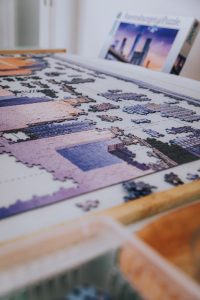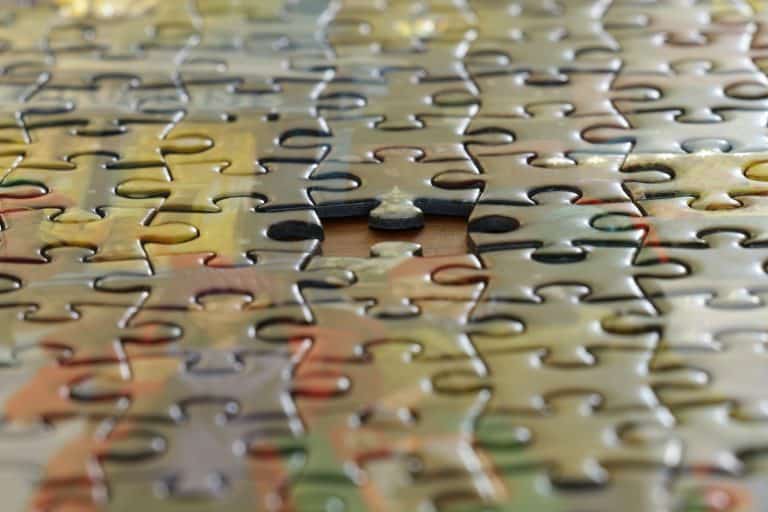There’s a unique satisfaction that comes from finally putting the last piece of a jigsaw puzzle into place. You’ve put hours into sorting through hundreds, maybe thousands, of puzzle pieces, and now your masterpiece is complete. But what if those pieces have become dirty or dusty over time? You might be pondering, “What’s the best way of cleaning jigsaw puzzle pieces without causing any damage?
Well, you’re in luck, because we’re here to guide you through the process of washing your loved jigsaw puzzles. Whether your puzzle is an intricate scene of woodland critters, a complex cityscape, or a photo of your family turned into a keepsake, they deserve a proper clean once in a while, especially if they double up as wooden toys for your kids.
For cleaning your puzzle, you’ll need a puzzle mat of the material of your choice, which could range from a felt mat to a simple roll up one. Using the mat not just makes the cleaning process more neat but presents a secure and stable surface to lay your puzzle on for a wash. You want to make the right choice in order to avoid causing damage to your precious jigsaw puzzle. And of course, remember to be careful when applying the cleaning solution of warm water and gentle soap. You just want to wipe off the dirt, not soak your puzzle pieces. After all, cleaning them shouldn’t involve a trip to the dry cleaner!
Exploring the Importance of Cleaning Jigsaw Puzzles

Your love for jigsaw puzzles might have you overlooking an important aspect – cleaning! Especially if you have kids around, your jigsaw puzzles may hide unwanted germs and bacteria. It’s crucial to clean them regularly to ensure they’re safe for you and your family to play with.
Cleaning jigsaw puzzle pieces doesn’t mean you have to soak them in water. In fact, doing so might cause these puzzle pieces to warp. Warm water can soften the glue holding the layers of the puzzle pieces together. Wood, if your puzzles are wooden toys, can absorb moisture and deform too. What you’re looking for is a gentle and dry cleaner approach.
Use a soft, clean cloth or a sponge moistened with a mild cleaning solution to wipe each piece. Remember, your goal here is to avoid causing damage to the puzzle pieces while ensuring they’re clean. If you’ve been playing your puzzles on a felt mat or similar surface, give it a good wipe too. If your mat is washable, even better! You can simply roll it up, and wash it according to its washing instructions.
An effective method to clean your puzzle without getting it wet is to use a can of compressed air. Just a simple spray will lift dust and grime from your jigsaw puzzles. This solution is not only convenient but also quick, drying instantly and keeping your puzzle pieces in neat, playable condition.
Keeping your puzzles clean is not just about hygiene. It’s about longevity. The longer you keep your puzzles clean, the longer they will last. Plus, it’s certainly the right choice if you plan to pass them on to the next generation.
For your puzzle mat, whether it’s a felt mat or other materials, regular cleaning enhances the lifespan too. You don’t want a dirty mat dulling the vibrant puzzle pieces, do you? Besides, cleaning helps maintain the neat and orderly environment that puzzle building often requires.
Cleaning jigsaw puzzles and your puzzle mat is a task you should undertake carefully. But rest assured, with a bit of gentle care and the right tools, you can maintain your puzzles’ sparkle without a worry. Not only will they be germ-free, but they’ll remain a joy to play with for hours on end!
So, the next time your child reaches out to a jigsaw puzzle or you unroll your felt puzzle mat, bear in mind these tips. Cleaning is no longer a tedious chore but a step towards more enjoyable puzzle play. After all, clean puzzles and puzzle mats not only look nicer but feel nicer to play with. They’re bright, sparkling, and free of those invisible germs that could hitch a ride on your toys.
Step-by-Step Guide: How to Clean Your Jigsaw Puzzle
Cleaning your jigsaw puzzle doesn’t have to be a daunting task. With the right tools and approach, you can ensure your puzzle pieces stay neat, clean, and ready for the next time you’re yearning for a jigsaw challenge.
Considering most jigsaw puzzles are made of paper and cardboard, you need to be especially careful in order not to cause any damage. So, let’s dive into it – here’s your step-by-step guide to giving your favourite jigsaw puzzles a gentle clean.
Step 1: Prepare your Cleaning Solution Mix some mild soap with warm water in a sink or a large bowl. You don’t want it too soapy, just enough to create a gentle cleaning solution. This will ensure your puzzle pieces are cleaned without leaving a soapy residue.
Step 2: Wipe Down Each Puzzle Piece Take a soft cloth or sponge, wet it slightly with your cleaning solution, and ever-so-gently wipe down each puzzle piece. Remember to do this one piece at a time, avoiding the edges to prevent them from peeling.
Step 3: Dry the Puzzle Pieces After you’ve carefully wiped each piece, lay them flat on a clean, dry towel. Here, using a puzzle mat comes handy, especially a felt mat that absorbs moisture quickly. Simply roll out the mat, lay your pieces flat without overlapping, and let them dry naturally. Avoid exposing the pieces to direct sunlight to prevent colors from fading.
Step 4: Store Your Puzzle Once dry, store your puzzle safely back in its box or, better yet, invest in a puzzle mat. These are convenient for keeping your puzzles secure and tidy. If your children enjoy playing with puzzles, they might also enjoy rolling them up and tucking them away!
There’s no single “right choice” when it comes to cleaning jigsaw puzzles. Wooden toys might benefit from a different process, and some puzzles might be better cleaned with a dry cleaner or a quick spray of canned air. It’s all about making a careful, informed decision based on the materials your puzzle is made from.
So, don’t worry about those sticky fingers or little mouths around your jigsaw puzzles anymore. It’s easy to keep your puzzles clean and free from germs, dirt, and bacteria. Just remember, every puzzle is unique, so while this guide should cover most cleaning situations, take note of each puzzle’s specific needs. Enjoy hours of fresh, clean fun with your now sparkling puzzles!
Essential Tools for Cleaning Jigsaw Puzzles
You’re probably familiar with the satisfaction of completing a jigsaw puzzle. But what about the process of cleaning that jigsaw puzzle? It may not be as appealing, but it’s equally important. Maintaining your puzzle and the puzzle pieces clean and neat is crucial not only for its longevity but also for hygiene, especially when kids are involved.
So, let’s break down the essential tools needed for cleaning jigsaw puzzles. These items are likely already around your home, making it an easy, right choice to keep your puzzles in tip-top shape.

- Warm water and mild soap: Warm water and a splash of mild soap create a gentle yet effective cleaning solution. Remember not to saturate the pieces with water, though. A quick swish in the mixture followed by a thorough rinse should be enough. Excess moisture could warp or damage the puzzle pieces.
- Soft cloth or sponge: You’ll want to be careful when cleaning your puzzle pieces to avoid causing damage. Using a soft cloth or sponge to clean and wipe each piece ensures a gentle touch.
- Felt mat: Regardless if you have a puzzle mat or a felt mat, laying out your cleaned pieces on a dry, absorbent surface allows them to air dry correctly. Always try to lay out your pieces individually to ensure they dry fully and evenly. Avoid stacking them as it can trap moisture, leading to possible damage.
Don’t forget, it’s important to be extra cautious when cleaning puzzles that might have been used as wooden toys. Wood is more susceptible to water damage, so you might want to simply wipe them clean. Also, any puzzle that children have been playing with should be cleaned more frequently, as it could harbor bacteria and germs from little hands and mouths.
Routine cleaning doesn’t have to take hours or be a tiresome task. By setting aside a little time after each play session or after completing the puzzle, you can keep it clean and free of any residue. Not to mention, a clean puzzle is a pleasure to work on, free from sticky residues or grimy fingerprints!
Hopefully, the process of cleaning your jigsaw puzzles after a long session of games is a bit less daunting now. Armed with the right tools and tips, you’ll be well-equipped to extend the life of your puzzles while keeping them squeaky clean!
Tips and Tricks for Maintaining Your Jigsaw Puzzles

Picture this: you’re bent over a massive jigsaw puzzle, hours into the task, and you notice that the puzzle pieces have stains. Your wooden toys, too, are looking less than pristine. It’s a messy situation, but guess what? It is totally manageable. Cleaning your jigsaw puzzles and toys is straightforward with the right strategies.
First things first, avoid causing damage. Ensure you’re using a gentle cleaning method, especially for wooden toys. Contrary to what you might think, wood doesn’t take kindly to being soaked in water. Dab a cloth in a mixture of warm water and a mild cleaning solution, and gently wipe the surface of each piece. Desist from using a wet cloth as too much moisture will cause the wood to warp.
When cleaning the puzzle mat, felt mats offer the simplest method. Just give it a good shake to dislodge any dust or debris. If it’s a bit dirtier, a bit of gentle spot cleaning with warm water and soap will do the trick. Post cleaning, make sure to lay the mat flat to dry in a spot with good air circulation. Remember, don’t place it near a heater or in direct sunlight, as it could cause the mat to shrink or warp.
Concerning jigsaw puzzles, the cleaning process becomes a little trickier. Dunking them in warm water with a bit of soap isn’t recommended as it can cause the pieces to swell, warp, or peel. Instead, try a soft brush or a dry cleaner designed specifically for puzzles. Using a cleaning solution is also a viable option, but be extra careful.
If your puzzle is really filthy, it might need a bit more than a dusting or a wipe down. In such cases, a dry cloth dampened with a mild cleaner will come in handy. You should be ultra-careful to avoid causing damage to your puzzles through scrubbing- always remember to be gentle.
Also, germs and bacteria love children’s toys. So, after your kids finish playing, clean their puzzles and wooden toys by wiping them off with a safe and suitable cleaner. This will wipe away any lurking bacteria, making them clean and safe for your child to play with again.
DIY Solutions for Cleaning Jigsaw Puzzles
Cleaning jigsaw puzzles is an essential aspect of maintaining your collection. If you’re involved in puzzle play frequently, it’s crucial to keep your puzzle pieces free of dirt and grime. Wooden toys, in particular, can harbor bacteria, so they need extra attention. Don’t worry, though. We’ve prepared some simple DIY solutions that require nothing more than what you might find around your house.
Warm Water and Mild Soap
For most jigsaw puzzles, warm water mixed with a mild soap forms the basis of a gentle, effective cleaning solution. You’d be careful to avoid soaking the pieces, though, to avoid causing damage. Instead, a careful wipe with a damp cloth will suffice. When you’re done, lay the pieces out on a towel to air dry. This process ensures the pieces are clean with minimum damage.
Felt Mat for Drying
To avoid damaging your puzzle pieces as they dry, consider a felt mat. Not only does it protect the surfaces underneath from wet puzzle pieces, but it also provides a soft, secure place for them to dry. For convenience and careful handling, you can simply roll your washed pieces in the felt mat and leave them to dry.
Protective Spray
Another tip for keeping your jigsaw puzzles in top shape is to use a protective spray. It’s an excellent solution to keep bacteria at bay and maintain the cleanliness of your toys longer. Always test a small area first though to ensure it won’t cause any damage.
Dry Cleaner Bag
An unconventional yet innovative way to handle cleaning a jigsaw puzzle lies in your dry cleaner bag. Place the puzzle pieces inside, add some baking soda, and shake it for some minutes. The baking soda will absorb all the dirt and leaving your puzzle pieces neat and clean.
To keep your beloved jigsaw puzzles in their best form, you’ve got to keep them clean. With these easy DIY cleaning solutions, you can make the task easier and more efficient. So, next time your kids finish a marathon puzzle session, you’ll be well-equipped to handle the cleanup. Cleansing your puzzles doesn’t have to be a complicated process, but a regular routine of cleaning will ensure hours of puzzle fun without unwanted germs spoiling the game. It’s one of those surefire ways to secure the longevity of your favorite puzzle pieces. Imparting an excellent cleaning routine will also inculcate a sense of responsibility in your children, recalling the popular idiom, ‘cleanliness is next to godliness.’
Storing Your Cleaned Jigsaw Puzzle: Best Practices

Once you’ve spent precious hours fitting together each piece of your jigsaw puzzle, you’ll want to keep it in tip-top shape. But how do you ensure your cherished puzzle pieces are stored correctly without causing any damage, especially after a thorough cleaning? Let’s delve into the best practices for storing your cleaned jigsaw puzzle.
Puzzle Mat Storage: A puzzle mat can be a lifesaver, especially for jigsaw puzzles that you are still working on. These mats provide a firm and secure surface for your puzzles to lay flat on. Once you’ve cleaned your jigsaw puzzle pieces, simply roll the mat up with the pieces inside.
Ensure your pieces are absolutely dry before rolling them up in a felt mat to avoid trapping any residual moisture which can warp the pieces. This mat also keeps your pieces tidy and neat, protecting them from damage.
Oversized Jigsaw Puzzles: For larger-than-life jigsaw puzzles, storing can be a bit tricky post-cleaning. You can opt for flat under-bed storage containers that provide a secure and dry space. Remember, your puzzles needed to be completely dry before you put them into long-term storage, you don’t want the moisture causing harm.
When it comes to wooden toys or puzzle pieces, maintaining the quality of the wood is crucial. Once you’ve cleaned the puzzle with a gentle cleaning solution and warm water, let it air dry thoroughly.
Kid-specific Puzzles: If you frequently clean your child’s jigsaw puzzles, you’d know that they can end up everywhere – in mouths, in the sink, outside in the dirt. After every wash, keep them in a secure container to keep them free from germs, bacteria, or anything else they might pick up.
Storing your puzzles correctly is just as crucial as cleaning them. Following these tips will ensure that your puzzles remain safe, undamaged, and always ready for the next play session. The important thing is to ensure that things are completely dry before they go into storage and that the storage method does not create unnecessary pressure on the puzzle pieces. Happy puzzling!
Final Thoughts: The Art of Keeping Your Jigsaw Puzzle Clean
Keeping jigsaw puzzles clean not only aids in their longevity but also ensures their safe use, especially around children. The article presents a detailed guide on how to gently and effectively clean your puzzles and puzzle mat without causing damage. The tips range from preparing a mild cleaning solution, wiping and drying each puzzle piece properly, using tools like a can of compressed air, to storing the puzzle pieces appropriately after they are cleaned. Sparing some time after each puzzle play session for cleaning can keep them free from dirt, grime, bacteria, and increase their lifespan. With this guide, maintaining a hygienic, sparkling puzzle collection is a stress-free process that only adds to the joy of puzzle play.
Other suggested articles:

